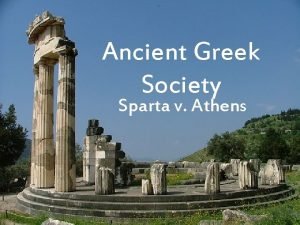Autonomy Autonomy Ancient Greek autonomy one who gives














- Slides: 14

Autonomy

Autonomy • Ancient Greek: – autonomy = „one who gives oneself their own law“ • au·ton·o·my: – Independence or freedom, as of the will or one's actions: the autonomy of the individual. – The condition of being autonomous; selfgovernment, or the right of selfgovernment; independence

Types of autonomy • Autonomy of environment • Social autonomy • Operational autonomy / autonomy of control – Goal autonomy

Why is autonomy desirable? • ≈Same reasons as for AGI • Reduces or eliminates human control and intervention – Less operational cost – Highly autonomous systems more reusable • Building learning, flexible, self-adaptive systems that can operate without complete pre-specification of tasks • Central feature of human intelligence

Autonomy • Task fully specified? • Task only focused towards external environment? • Task involves learning? • Autonomy is closely related to intelligence – Learning to perform partially specified or unspecified tasks requires intelligence

Autonomy • Most current “autonomous” systems are built to operate in conditions more or less fully described a priori, which is insufficient for achieving highly autonomous systems that adapt efficiently to unforeseen situations. • Fully specified operation – – • Operating contexts must comply with specification Systems not meant to change E. Nivel & K. R. Thórisson: Self-Programming: Operationalizing Autonomy – – Behaviorally autonomous systems Change as desirable and controllable phenomenon • – Automatic adaptation • – • Structural autonomy Adaptation is used here in a strong sense as the ability of a machine not only to maintain but also to improve its utility function and so, in partially specified conditions with limited resources (including time) and knowledge. IKON FLUX In our view, autonomous systems automatically perform tasks in some environment, with unforeseen variations occurring in both, through some type of automatic learning and adaptation that improves the system's performance with respect to its high-level goals

Autonomy • Weak autonomy – Systems that require some degree of human control to perform target tasks • Medium autonomy – Systems that perform fully specified target tasks without human intervention • Strong autonomy – Systems generating own goals that learn to adapt to unforeseen varations and perform new tasks without human control

Autonomy • Autonomy = (system S, task T, context C) – From Sanz 2000 • System S is autonomous if it can fulfill task T in context C A refrigerator (SYSTEM = ”refrigerator of Alex”) is autonomous because it can fulfill its task (TASK = ”keep the interior temperature at 5° C”) in a specific context (CONTEXT = ”Interior of a house in Philadelphia”)

Automatic vs Autonomous

AFLUS autonomy framework • http: //www. nist. gov/el/isd/ks/upload/ALFUS-BG. pdf

Autonomy Comparsion Framework for AGI systems (Thórisson & Helgason)

Autonomy dimensions • Learning – Enables system to handle novel situations and task varations • Meta-learning – System improves own operation, increasing its capacity to solve complex tasks • Realtime – Failure to keep up with the environment reduces autonomy and overall operation • May introduce artificial pauses etc. • Resource management – Autonomous operation involving multiple simultaneous cognitive processes, complex environments, limited resources and time constraints requires sophisticated management of resources

Evaluation of selected AGI systems

Qualitative comparison
 Beneficence ethics
Beneficence ethics Means of communication in ancient times
Means of communication in ancient times Ancient india vs ancient china
Ancient india vs ancient china One god one empire one emperor
One god one empire one emperor One one one little dogs run
One one one little dogs run One king one law one faith
One king one law one faith Byzantine definition
Byzantine definition Ford one plan
Ford one plan See one do one teach one
See one do one teach one See one, do one, teach one
See one, do one, teach one Structure of twelfth night
Structure of twelfth night See one do one teach one
See one do one teach one Asean tourism strategic plan
Asean tourism strategic plan Asean one vision one identity one community
Asean one vision one identity one community Past simple tense markers
Past simple tense markers



























